Curling Is Not a Sport. There, I Said It.
Norfolk Curling Club, Norfolk
February 20, 2010
Note: Some jackasses burned down the curling shed in 2011. But it has risen from the ashes and is back open in late 2013! This makes me very happy.
You are not really a fan of curling. Oh sure, you pretend to be during the Winter Olympics every four years but you’re only lying to yourself and annoying your circle of Facebook friends. Trust me.
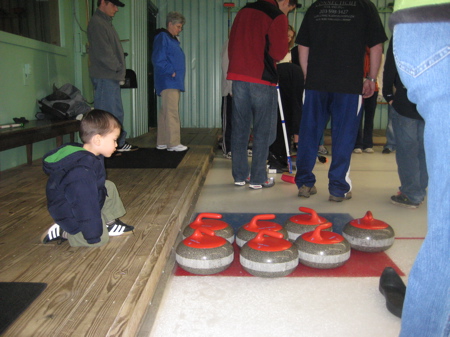
Ask yourself the following questions: Beyond the basics, do I know the rules of curling? Do I know the name of a single curler? Have I ever curled in my life? Would I pretend to like shuffleboard as an Olympic sport? Have I watched an entire curling match? Would I even know if I had?
Unless you’ve come to this page as a curler looking for curling rinks in Connecticut, you answered every one of those questions “no.” So why do so many people pretend to enjoy it? It’s crazy to me… If I were to pretend to like a “weird” Olympic winter sport, it would be modern biathlon. It takes incredible strength, fitness, skill and training. But I don’t pretend to know any modern biathletes.
And since I’m on this tangent, all these new sports are terrible. Short track speedskating, snowboard cross… Nonsense.
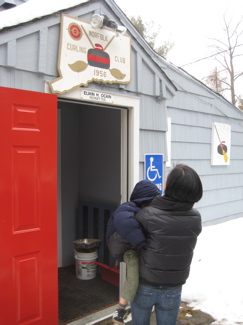
So… Curling. Connecticut has two curling sheds; the Nutmeg Curling Club in Bridgeport and the Norfolk Curling Club. I somehow found out that the Norfolk club was having an open house during the Olympics to capitalize on the fervor so we made a date. After stops at the Peter Greenwood Glassblowing Studio in Barkhamsted and the CH Pease Natural History Museum in North Canaan, we arrived at the club headquarters nestled deep in the woods off of Mountain Road in Norfolk.
(The same Mountain Road that one can take deeper into the woods on their way over to the Rustling Wind Creamery like we did here.)
The small parking lot was nearly packed with cars and I must admit, I was rather excited to get in there and throw some stones. But first, let’s learn a little about this game (it’s a game, not a sport) from the US Curling Association:
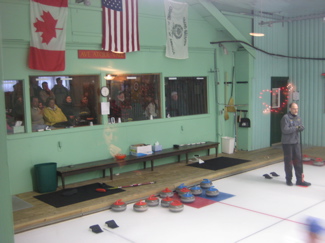
The oldest artifacts from the ice sport of curling are stones which prehistoric people slid toward a target along frozen rivers or lakes. These people may also have used primitive brooms to clear snow from the path of their sliding stones.
In 1565, Holland’s Peter Breugel painted “Hunters in the Snow” and another work depicting scenes resembling modern curling. Breugel’s paintings support the premise held by some that curling originated in continental Europe. The Scots, however, are the undisputed developers and formalizers of the modern game. By 1638 curling was considered, with golf and archery (in M. H. Adamson’s poem The Muses Threnodie), to be a usual recreational pastime. After a huge growth spurt in the 19th century, curling was played by thousands in nearly every Scottish parish.
CTMQ Notes: Golf and curling? The Scots are a lazy sporting lot.
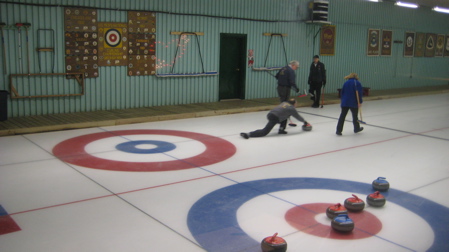
By the way, at the time of our visit, Norfolk’s First Selectwoman (aka Mayor) was an active club member
Between the 16th and 20th centuries, Scotland’s climate warmed, and today the lochs rarely freeze. The climate change hindered curlers, who played outdoors on natural ice until the 20th century. Nonetheless the Scots had, by the mid-1800s, formalized curling’s rules of play and equipment and had established the “mother club” of curlers worldwide, the Royal Caledonian Curling Club. The RCCC is today the national governing body of curling in Scotland, with 20,000 active members now playing indoors on refrigerated ice.
The game of curling spread throughout the world through the efforts of thousands of Scottish soldiers and émigrés. In North America, curling’s origins likely date to the late 1700s. The first documented record is the founding of the Montreal Curling Club in 1807.
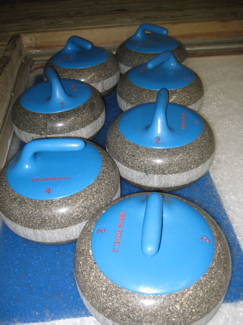
In 1832, the Orchard Lake Curling Club, near Detroit, became the first curling club in the United States, organized at the home of Dr. Robert Burns. The Orchard Lake group curled on Lake St. Clair. The oldest continuously operating curling club in the United States is the Milwaukee, Wisconsin club, founded in 1845. The Scottish founders’ roster included such names as Murray, Ferguson, Dunlop, Gunyon, Findlay, Kinney, McFarland and McFadyen.
Since the mid-1800s, curling has spread and thrived in northern states, including Wisconsin, Minnesota, and North Dakota, and also in the Great Lakes, New England and mid-Atlantic states. There are dedicated pockets of curling activity in other states, including Alaska, Washington, California, Texas, Colorado, Nebraska, Kansas, Missouri and North Carolina. In all, there are active curling clubs in 26 states in the nation.
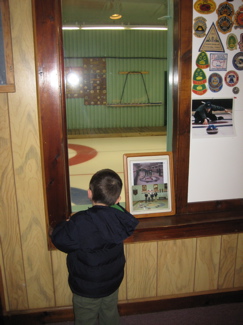
In the United States today, there are over 15,000 curlers in over 135 clubs, most of which own their ice facility. While many U.S. curlers have Scottish roots, modern curling club membership rosters tend to reflect an ethnic cross-section of their communities, which are preponderantly small-town rural. The largest curling club in the USA is the St. Paul, Minnesota, club, with over 700 members.
The United States Curling Association (founded 1958) governs curling in the USA. Like that other Scottish sport, golf, curling is both a recreational and an athletic pastime, marked by a strong code of fair play and courtesy (The Spirit of Curling). The USCA is a member of the U.S. Olympic Committee and the World Curling Federation, and has 131 member clubs in 11 regions. Curling debuted as a medal sport in the 1998 Winter Olympic Games in Japan. About 1.5 million people from ages eight to 80 in over 33 countries curl.
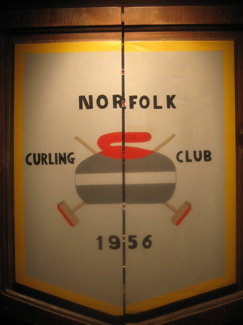
The best-known American curler is Raymond “Bud” Somerville, of Superior, Wisconsin, the first inductee into the USCA’s Hall of Fame. Somerville skipped his team to its first world championship in 1965, at age 28. In 1992, at age 55, he skipped his team to a bronze medal at the Albertville Olympics (curling was a demonstration sport).
The ice sport of curling, although never well known in the United States, has developed steadily throughout American history. The sport is often passed down through families and has provided enjoyable winter recreation to thousands of Americans.
There. Now you know more about curling than you did 4 minutes ago, to make your pretend love of it a little more real.
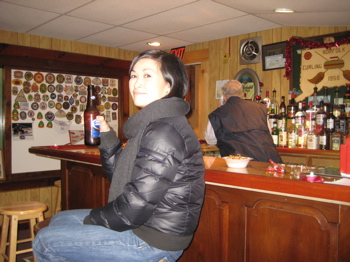
Once inside, I was immediately struck by the warmth and hominess of this place. Several curlers milled about the lobby area, offering friendly advice and such. We were invited to sit and watch a match while a member of the club explained the game unfolding before us. The terminology, the strategies, the skill required, etc. It was a very nice set up and was rather entertaining.
There was another room next to the viewing area/lobby – the bar. Ahhh, so this is why people come out here to the middle of the dark wood. I get it now… Yes, the social aspect of curling appears to be as much of an important facet as the actual curling. The bar area was inviting and the gentleman behind the bar was personable and fun to talk to.
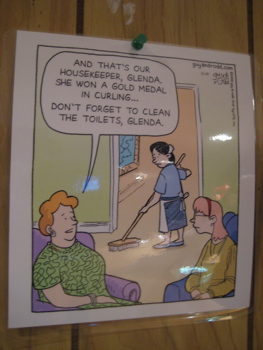
Damian munched on some pretzels. And a carrot. And a celery stick. And a cookie. And a brownie – while his mama enjoyed a $2 Bud Light. That’s right, I said two dollars. Hm, it’s beginning to become clearer how this could be a fun pastime. Now that we were settled into the bar, watching live curlers through the viewing windows with Olympic curling on the large TV in the bar, it’s time for old time Norfolk curler Ted Childs to give us the history of the club:
The Norfolk Curling Club was established in 1953. Several sets of oddly assorted stones were kindly brought to Norfolk from the (now defunct) Farmington Curling Club. For our first two years games were played outside on Tamarack and Tobey Ponds.
During the Autumn of 1956, the original Norfolk curling shed was built. This is the date from which we mark our first official year of curling at the Norfolk Curling Club. However, it was not a permanent structure, consisting of a wooden building resembling nothing so much as a tobacco barn with apertures for letting in cold air at night to freeze the ice, as there was no ice making equipment. The first curling in the shed took place on New Year’s Day of 1957 with the temperature sitting at 10º below zero.
By the Autumn of 1958, artificial ice-making machinery was installed, making it possible to hold the first Norfolk Men’s Invitational Bonspiel in December of that year. In 1959 the club purchased thirty-two matched Ailsa Craig granite curling stones, leaving behind for good the more colorful relics of a prior age. The old curling shed was later replaced with an insulated metal building along with enlarged locker and equipment rooms. In the summer of 1997 new lighting and a concrete floor with new pipes were installed in the Ice Shed. In the summer of 2000 we installed a fine new roof over the Ice Shed.
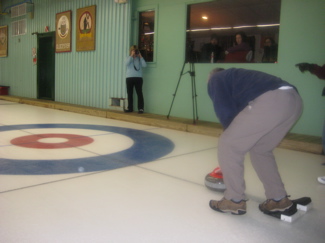
That blurb reminds me – Norfolk is locally known as “The Icebox of Connecticut” because it has the lowest average annual temperature of any Connecticut town. Anyway, after about a half hour of explanation, it was time to hit the ice. As you can see from the pictures, the NCC is a two-sheet shed. They let pretty much everyone down to the ice to give it a go, which was mighty nice of them.
Once on the ice, I immediately noticed the difference from what I’m used to. It’s a bit stickier and has little bumps all over it. These bumps are called “pebbling” and they are integral in curling; allowing the thrown stone to have enough friction to curl one way or the other. You see. The pebbling is created by misting water onto the frozen surface. I just found and read this interesting piece on making world class curling ice.
(Hockey ice is a touch less than an inch thick and is maintained at 18 to 21 degrees whereas curling ice is a touch more than an inch thick and is maintained at 19 to 26 degrees.)
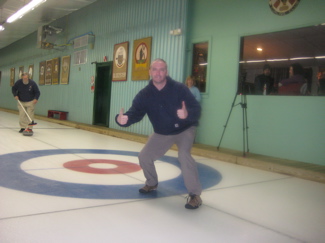
Then the fun began – we were given a little bit more of hands on instruction (put your foot in the hack and just push the 42 pound stone forward and give it a twist as you release, etc.) It was impossibly easy – but of course I wasn’t exactly being called on to have a curler’s touch yet. The random women I was learning with seemed to have a bit of difficulty with the simple instructions. The whole point was to “curl” the stone (spin it slightly) in these initial throws and these women would let it go with absolutely no spin on it whatsoever. The guy teaching us was a bit frustrated noting (politely), “it’s called curling. The point is to curl the stone!”
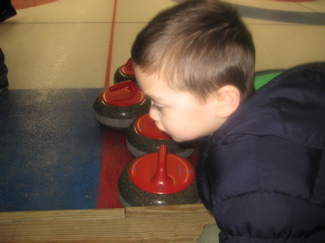
It was pretty funny to me… Especially seeing as though I was a natural and all. (Seriously, the random women were oohing and aahing over my nasty curling skills.)
Hoang and Damian joined me for a while but never tried a throw. But the whole atmosphere was really fun and we had a blast.
I’ll admit, doing a real throw does require a modicum of coordination (push, slide, look down the ice, curl properly, right amount of speed), and to get good at this, I’m sure, is incredibly frustrating – just like golf. Which is why there’s a bar attached – just like golf. And why there are “gentleman’s rules” in curling – just like golf. It all started to make sense to me.
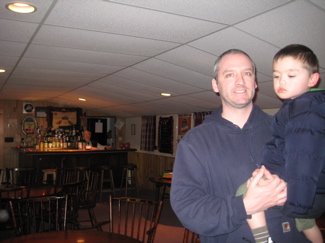
I did a couple throws and got my stone into the house once. Applause all around. Of course, by then Hoang was back in the bar area with Damian, but I can’t blame them. As Hoang said, regarding curling before we went, “It’s stupid. If you’re going to sweep, let it be for cleaning purposes.”
I can’t say I disagree. The whole sweeping part is impossible for me to get behind. Ostensibly, they do it to created the path for the stone to take by melting a tiny layer of ice, but it’s patently absurd. I refused to “learn how to sweep” and joined my family. Back in the day, the brooms used were actual straw brooms which I refuse to believe had an substantive effect on the 42 pound granite stone, especially on lake water.
Which brings me to my conclusion: Curling is not even close to being a real sport and it’s not remotely fun to watch. (I tried watching some a couple nights ago and fell asleep within minutes.)

But it IS fun to do it and I’m sure the strategy is cool to sort out. But really, the whole reason this thing exists is because drinking is such a part of it – drinking and socializing. Which is FINE, but it doesn’t make it a sport.
I’ve been invited back to a real curling clinic (at least until they read my indictment of their game here) because I was so awesome at it. And truthfully, if Norfolk were closer, I’d totally go:
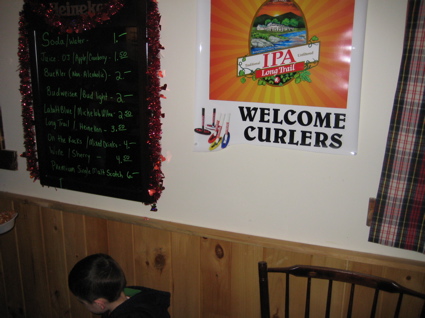
Totally.
Norfolk Curling Club
Recent NYT article on Nutmeg Club
Cool Curling technology
Not Convinced?

 ron says
ron says
February 25, 2010 at 9:09 pmsport – a practiced skill that elevates the heart rate due to physical exertion – running, jumping, lifting, etc. when you finish you need a shower and a nap.
contest – same as above but the winner is decided by judges – figure skating, gymnastics, etc.
game – a practiced skill that requires talent but not physical fitness – golf, darts, pool, curling.
im into nordic combined as my odd winter olympics sport.
 carson Schultz says
carson Schultz says
March 3, 2011 at 7:13 pmsturling is the 2-person team sport of curling
please arrange to link http://www.sturling.net
to your web site.